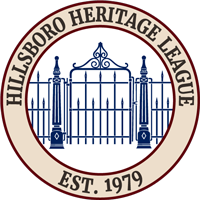Living Legacy of the Terrell Gaines Hawkins Family
A popular game after Christmas is to fashion New Year’s Resolutions that project hopes and dreams for the year (or decade) ahead. The Hillsboro Chamber has developed a list of individuals to its Hall of Fame and now Hill College presents Pillars of the Community. Legacy frequently is defined as that which someone leaves behind for future generations, or as the philosopher/educator William James wrote, “The great use of life is to spend it for something that will outlast it.”

In the annals of Hillsboro history, we believe it would be correct to say that no family has contributed more to the development of our city than that of T. G. and Alice Mills Hawkins. Terrell Gaines Hawkins was born April 4, 1850 in Rutherford County, NC and came with his brothers to Texas in 1872. After a short stint as farmer on Jack’s Branch, he worked as cabinet maker in Upshur and Dallas counties before returning to Hillsboro in 1878 when he established Hawkins & Lary Hardware Company on the west side of the Courthouse Square. A two-story brick building was erected c. 1883 and now exists at 56 North Covington Street as a one-story home to Champion Credit.

Hawkins sold the hardware company to A. L. Smith and E. B. Stroud in 1890, and after Tomlinson joined the firm, the name changed to Smith & Tomlinson; their new building was constructed at 123/125 East Elm. Hawkins later purchased the old Iron Front Saloon/Greek-American Candy Kitchen Building at 56 West Elm. The building today is home to Covington Credit and known for the iconic horse mounted on the front of the building. But the exterior façade still carries T. G. Hawkins as did the hardware store on North Covington before the upper floor was removed.

On July 15, 1879 Hawkins married Nannie Alice Mills, daughter of W. S. Mills, owner/operator of the Mills House Hotel located on the southeast corner of Gould and South Waco Streets. The Hawkins first lived at 130 South Waco, now part of the Brookshire parking lot. Alice was born in Iredell County, NC but was raised with her family in Panola County, Mississippi. Alice’s mother died in 1864 and Mills married a widow-neighbor Mariah Randolph Middleton. The Mills were charter members of Hillsboro’s Southern Presbyterian Church, and T. G. Hawkins joined the Presbyterian Church after marriage to Alice and continued as a leader in that congregation until his death December 28, 1930. Alice Mills Hawkins served as Sesame president in 1909 and was instrumental in organizing a class to teach young ladies the fine arts of hospitality and social grace. Alice Hawkins died at home at 318 Craig Street in Hillsboro in 1944.
T. G. Hawkins was not only a successful businessman, but he also was a visionary leader for Hillsboro and Hill County. When the Hook & Ladder No. 1 was organized in June 1883, it was housed at 118 South Waco (current Hillsboro City Library) and just a few steps from the Hawkins home. He was a charter member and served continuously as Treasurer of the Hillsboro Fire Department until his death in 1930. His framed photo is on display in the Council Chambers at Historic City Hall.
Hawkins served for over seven years on the Hillsboro City Council and was instrumental in bringing the first telephone service to the city. He was a key player in locating the MK&T rail line in Hillsboro in 1881 and was signer of the bonds with MK&T to purchase right-of-way for the railroad. Later he would work to encourage MK&T to locate railroad shops in Hillsboro at South Yards. He worked to bring a water and electricity system to the city and was a proponent of the Good Roads Movement. It was Hawkins’ strategic planning that led to the 1885 bond issue for erection of Central School; he was a strong advocate for public education.
After sale of the hardware business, Hawkins moved into the financial field as president of Sturgis National Bank. It was under his leadership that the Victorian façade of the bank building at 50 West Elm was redesigned to reflect Greek-Revival architecture. When Sturgis Bank was consolidated with Citizens National Bank in 1912, Hawkins became chairman of the board.
